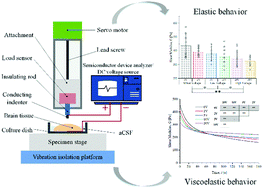Indentation response in porcine brain under electric fields
Abstract
Electric fields in the environment can have profound effects on brain function and behavior. In clinical practice, some noninvasive/microinvasive therapies with electrical fields such as transcranial electrical stimulation (tES), deep brain stimulation (DBS), and electroconvulsive therapy (ECT) have emerged as powerful tools for the treatment of neuropsychiatric disorders and neuromodulation. Nonetheless, currently, most studies focus on the mechanisms and effects of therapies and do not to address the mechanical properties of brain tissue under electric fields. Thus, the mechanical behavior of brain tissue, which plays an important role in modulating both brain form and brain function, should be given attention. The present study addresses this paucity by presenting, for the first time, the mechanical properties of brain tissue under various intensities of direct current electric field (0, 2, 5, 10, 20, and 50 V) using a custom-designed indentation device. Prior to brain indentation, validation tests were performed in different hydrogels to ensure that there was no interference in the electric fields from the indentation device. Subsequently, the load trace data obtained from the indentation-relaxation tests was fitted to both linear elastic and viscoelastic models to characterize the sensitivity of the mechanical behavior of the brain tissue to the electric fields. The brain tissue was found to be softened at a higher electric field level and less viscous, and substantially responded more quickly with an increase in electric field. The explanations for the above behaviors were further discussed based on the analysis of the resistance and thermal responses during the testing process. Understanding the effect of electric fields on brain tissue at the mechanical level can provide a better understanding of the mechanisms of some therapies, which may be beneficial to guide therapy protocols.



 Please wait while we load your content...
Please wait while we load your content...